It’s easy to forget about Singang (新港) in Chiayi County, even though it plays a key role in one of the world’s largest annual religious events.
Since 1988, the multi-day parade that celebrates the birthday of the sea goddess Matsu (媽祖) has stopped at Singang’s Fengtian Temple (奉天宮). Each spring, hard-core pilgrims set out from Dajia Jenn Lann Temple (大甲鎮瀾宮) in Taichung. They walk southward as far as Singang, then begin the return leg of their epic journey.
Some years back, I visited Fengtian Temple a couple of times, and did a bit of exploring in the streets near that shrine. But it wasn’t until a few weeks ago, when I was scanning a map, looking for places easy to reach by public transportation, that Singang returned to my consciousness.
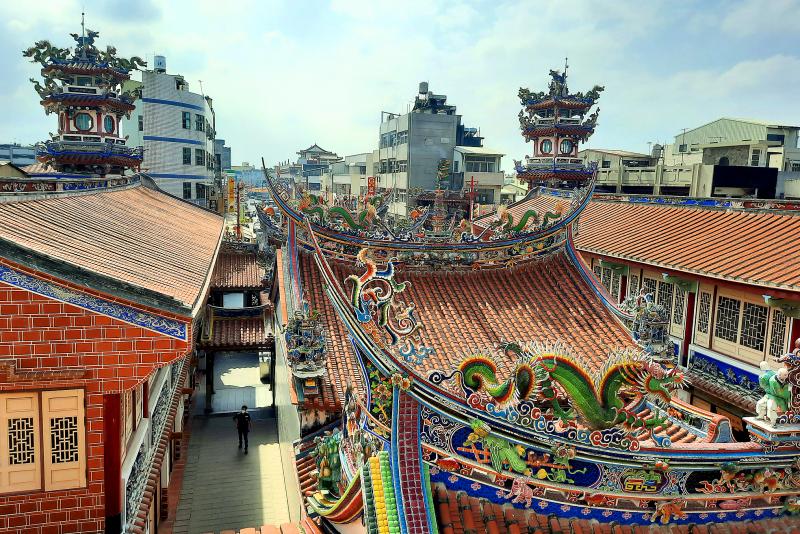
Photo: Steven Crook
Once I’d confirmed that buses set out from Chiayi every hour, my mind was made up. The weather had something to do with it. In this season, tramping through the countryside can be pleasant. I wanted to visit a few places on the outskirts of the town, and a good pair of shoes would make up for not having a vehicle of my own.
RURAL ARTIFACTS AND INCENSE
Three days later I was on a No 7325 bus bound for Beigang (北港). I didn’t move from my seat as it passed through the built-up part of Singang. Just west of the high-speed railroad, I stepped off the bus and turned down a side road in search of Dingcaiyuan Cultural Artifacts Hall (頂菜園農村博物館).
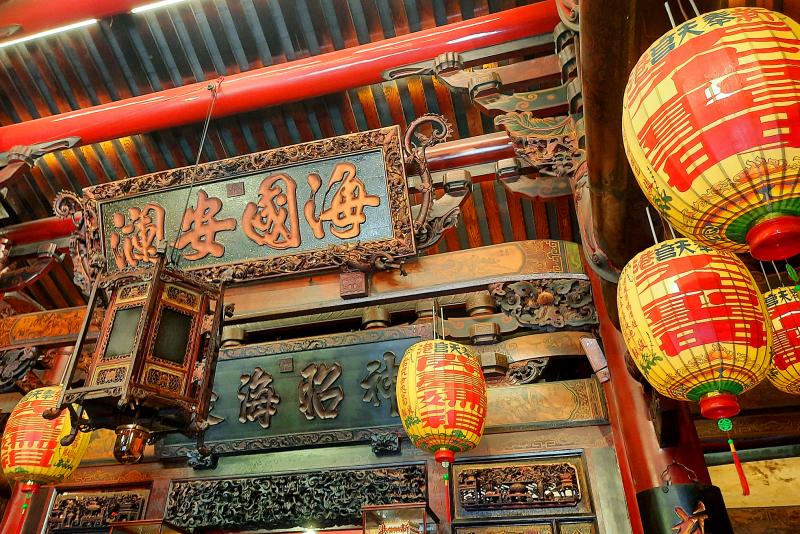
Photo: Steven Crook
The Chinese-language name of this open-air museum is more precise than the English version.
It preserves an odd yet photogenic collection of rural paraphernalia, everything from agricultural tools to the kind of motorcycles ridden by farmers and mail carriers. As admission costs just NT$50, I figured there was nothing to lose.
Apart from a group of senior citizens learning how to turn sweet potatoes into a delicacy, it seemed I was the only visitor that morning. The hall’s owner, Mr Chen (陳), invited me to watch a short video about the place and the demonstrations of traditional farming methods that it organizes from time to time.
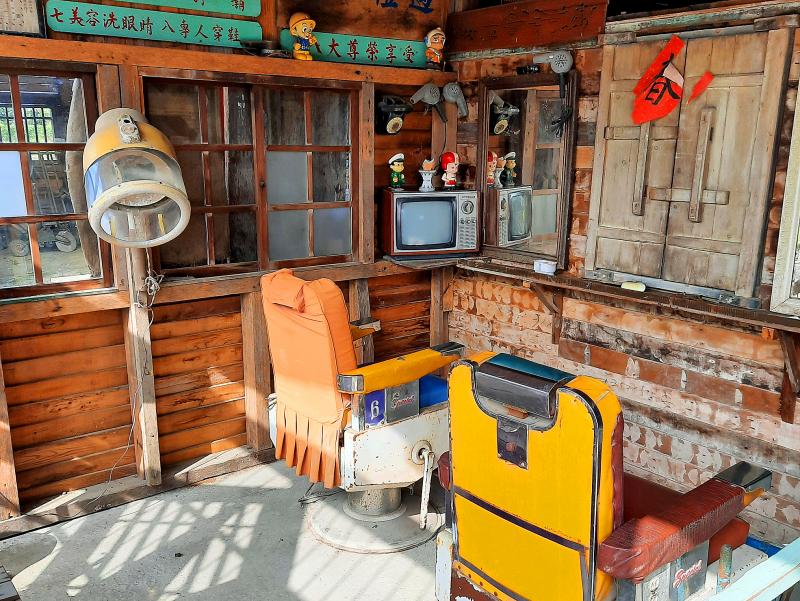
Photo: Steven Crook
I asked him how he’d acquired the objects on display. Some he bought, he said, but many were donated by people who had no use for them. Others were retrieved from scrapheaps.
In addition to old signs and items of furniture, there are bakelite telephones, sewing machines, clothes irons, hair-dryers and old-style portable scales. There’s even a movie projector.
The site is a graveyard for vehicles, including Vespas and a police motorcycle. Murals have been painted on the sides of a couple of buses and some old sugar-industry rolling stock, but otherwise these vehicles have been left to deteriorate. At least the resident animals — a few goats and a couple of water buffalo — look well cared for.
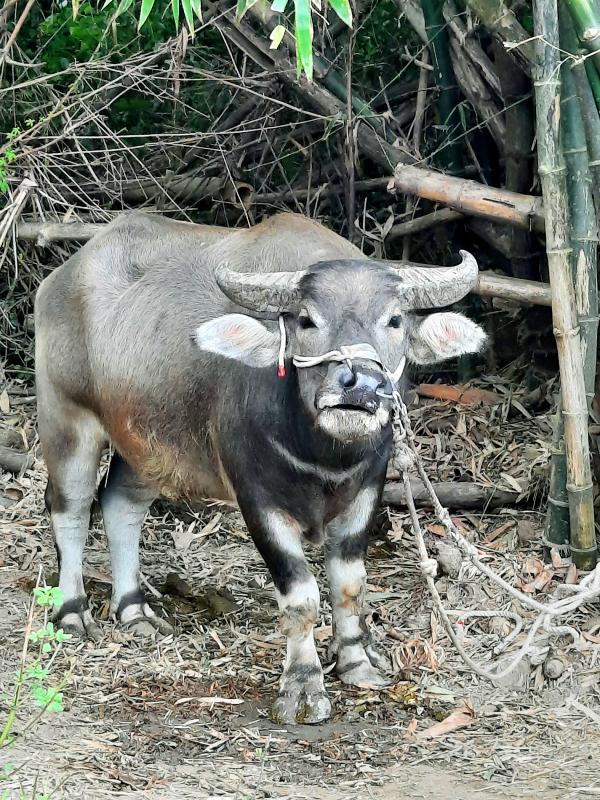
Photo: Steven Crook
Dingcaiyuan Cultural Artifacts Hall would benefit from a bit more labelling, but if you’ve any interest in vintage artifacts, it’s certainly worth a look.
Walking back toward the town center, it took me less than 20 minutes to reach Daching Incense Factory (大慶製香廠), which is on the north side of Road 159, a short distance inland of the high-speed rail line.
As a rule, I like to travel midweek to avoid crowds. That said, Daching Incense Factory is best visited on a weekend in good weather, when visitors can tour the workshop and take photos of thousands of gloriously colorful incense sticks arranged under the sun.
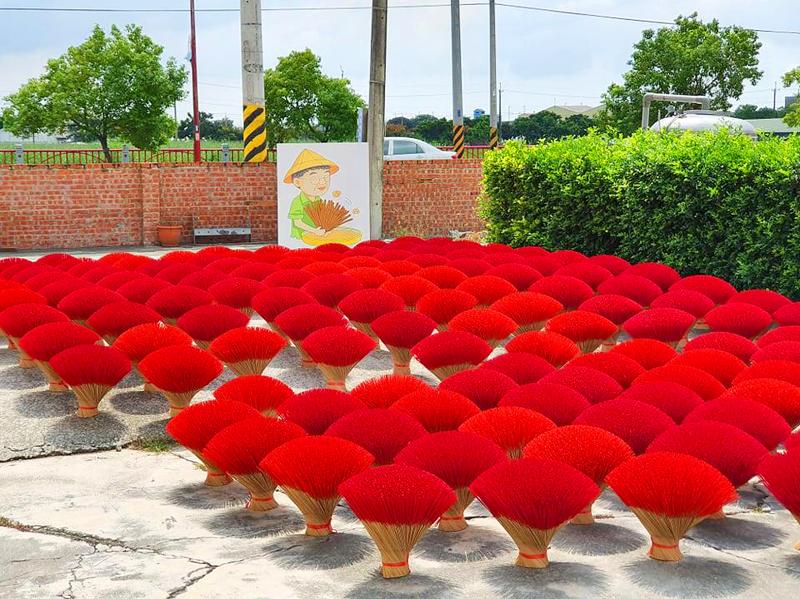
Photo courtesy of Daching Incense Factory
When I dropped by, the production area was closed to non-staff, and the incense sticks drying outdoors were a boring shade of brown. Even so, I learned a few things from one of the employees. The raw materials from which this century-old business makes incense are mostly imported from Australia, Indonesia or Vietnam. The incense sticks they usually make are priced from less than NT$1,000 per 600g packet to more than NT$3,000. But, the employee told me, they sometimes receive orders to manufacture incense that costs over NT$30,000 per taijin (600g).
Daching’s shop is open from 9am to 4pm every day. Parking nearby shouldn’t be difficult.
CELEBRATING MATSU
Opting to eat before going to Singang’s most famous place of worship, I walked to what’s probably the town’s best-known food business. Singang Duck Thick Soup (新港鴨肉羹), located 170m south of the temple on Jhongshan Road (中山路), specializes in the dish for which it’s named.
For NT$40, you get a medium-sized bowl of flavorful soup with a reasonably generous amount of meat. The popularity of duck in Singang isn’t surprising; the adjacent township of Minsyong (民雄) is synonymous with duck and goose farming.
As you’d expect of a shrine involved in the Dajia pilgrimage, Fengtian Temple is dedicated to Matsu. But like most Taiwanese temples, it hosts a mini-pantheon. The Chinese deity of war and martial arts Guan Gong (關公) is here, as is Wenchang Dijun (文昌帝君), a deity often prayed to by Taiwanese hoping to do well in major examinations.
Far more unusual is the prominence given to the Tiger Lord (虎爺), sometimes called the Tiger General (虎爺將軍).
In other temples that house a statue of the Tiger General, it’s almost always hidden away at ground level, below the deck that holds human-like effigies. But here it has a chamber and altar of its own in the temple’s west wing. If you’re facing the main altar, leave by the door on the left and you’ll see the Chinese-language sign for it (虎爺殿, Hu Ye Dian).
Because the altar chamber was filled by people offering incense and joss paper to the Tiger General, I had to wait a while before I could get in and take a look.
In addition to numerous and varied tiger effigies, I noticed boxes of eggs (left by worshippers who know they’re the deity’s favorite food) and a ceramic basin that contained water and NT$1 coins. If you make a donation, you should scoop out two of the coins and place them in a sealable plastic bag along with some of the water. If you store this at home for three days, then sprinkle the water, it’s said that the Tiger General’s blessings will help money flow into your household.
According to a 2015 blog post by Jacob Tischer, who’s currently studying for a PhD in anthropology at Boston University, worship of the Tiger General at Fengtian Temple is an expression of “communal pride, a sense of local attachment and identity.”
Traditionally seen as a protector of children, the image of the Tiger General has begun to change, Tischer writes, as “efforts to create a more generally appealing depiction of the deity have opened up and vulgarized his meaning as a wealth-generating agent similar to other gods.”
Like the birthday of Matsu (celebrated on the 23rd day of the third lunar month), the Tiger General’s birthday (the sixth day of the sixth lunar month) is an excellent opportunity to see the rites and performance troupes that give local popular religion its character.
If you can tolerate crowds and noise, you’re sure to enjoy them. Whatever your beliefs.
Steven Crook has been writing about travel, culture and business in Taiwan since 1996. He is the author of Taiwan: The Bradt Travel Guide and co-author of A Culinary History of Taipei: Beyond Pork and Ponlai.

This month the government ordered a one-year block of Xiaohongshu (小紅書) or Rednote, a Chinese social media platform with more than 3 million users in Taiwan. The government pointed to widespread fraud activity on the platform, along with cybersecurity failures. Officials said that they had reached out to the company and asked it to change. However, they received no response. The pro-China parties, the Chinese Nationalist Party (KMT) and Taiwan People’s Party (TPP), immediately swung into action, denouncing the ban as an attack on free speech. This “free speech” claim was then echoed by the People’s Republic of China (PRC),

Exceptions to the rule are sometimes revealing. For a brief few years, there was an emerging ideological split between the Democratic Progressive Party (DPP) and Chinese Nationalist Party (KMT) that appeared to be pushing the DPP in a direction that would be considered more liberal, and the KMT more conservative. In the previous column, “The KMT-DPP’s bureaucrat-led developmental state” (Dec. 11, page 12), we examined how Taiwan’s democratic system developed, and how both the two main parties largely accepted a similar consensus on how Taiwan should be run domestically and did not split along the left-right lines more familiar in

Specialty sandwiches loaded with the contents of an entire charcuterie board, overflowing with sauces, creams and all manner of creative add-ons, is perhaps one of the biggest global food trends of this year. From London to New York, lines form down the block for mortadella, burrata, pistachio and more stuffed between slices of fresh sourdough, rye or focaccia. To try the trend in Taipei, Munchies Mafia is for sure the spot — could this be the best sandwich in town? Carlos from Spain and Sergio from Mexico opened this spot just seven months ago. The two met working in the

Many people in Taiwan first learned about universal basic income (UBI) — the idea that the government should provide regular, no-strings-attached payments to each citizen — in 2019. While seeking the Democratic nomination for the 2020 US presidential election, Andrew Yang, a politician of Taiwanese descent, said that, if elected, he’d institute a UBI of US$1,000 per month to “get the economic boot off of people’s throats, allowing them to lift their heads up, breathe, and get excited for the future.” His campaign petered out, but the concept of UBI hasn’t gone away. Throughout the industrialized world, there are fears that